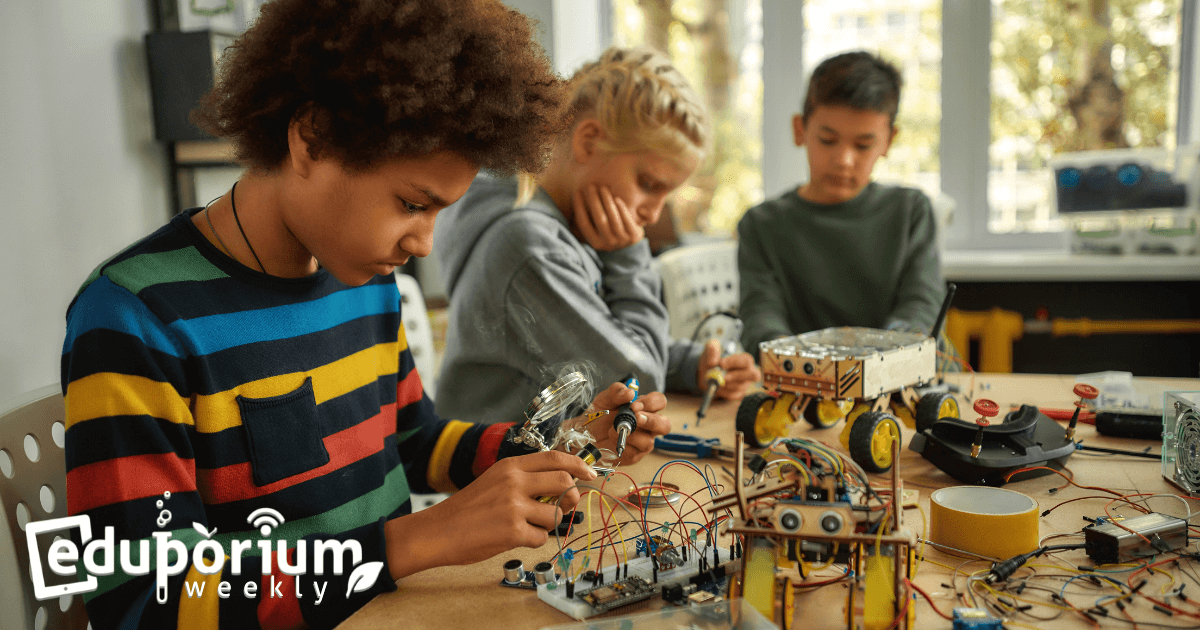We know there are certain skill sets that will serve students well in whatever types of future paths they take. We typically refer to them collectively as 21st century skills, which include a mixture of hard and soft skills, like creativity, persistence, collaboration, and communication. Hard skills, like coding and engineering, are also important, but, with this post, we’re focusing on one particular soft skill—inventiveness. Inventiveness, if you ask us, goes hand in hand with problem solving and creativity, but, despite how it enables educators to challenge children creatively, it's oftentimes overlooked. Luckily, inventiveness is key to STEM education and something students can work on as soon as they enter the classroom.
Tying Inventiveness with Problem Solving for Young Students
In today’s education world, instructional resources can sometimes be hard to come by in certain situations. Applying a maker mindset and using any available resources to invent and create, however, students have become somewhat accustomed to not wasting materials and looking in unlikely places to find them. This is also definitely true as it relates to students' inventions. A lot of times, there are some older materials in their schools, like fabrics, electronics, and more just laying around. Students have all sorts of projects they need to complete, however, for both their classes and for afterschool clubs. Using them as resources rather than forgetting about them is something that they've truly began to embrace. Whether they are looking for props for a play or designing a costume, chances are they'll find something to repurpose into something useful.
Looking to different places for the best solution or, at least, a solution that works is one approach students can then translate into other aspects of their lives and their education. Knowing that they could make some atypical resources work is something that'll help to boost their confidence and tends to help kids recognize that they can replicate this whenever they need to. At the same time, students know one of today's biggest problems is global warming, meaning conservation and recycling are crucial. When challenged to maximize materials, this helps kids become resourceful and understand why it makes their work easier. Plus, it's a lot of fun for students to think creatively and then to invent creatively as they really start to put what they have learned about using all resources into practice when inventing something or designing a new project.
Inventiveness skills are super beneficial and, as kids develop them, they'll also develop key critical thinking, collaboration, and communication skills. Being inventive means being resourceful and showing children the importance of using everything available to them (both physical and digital) in problem solving is also very helpful. Teachers can focus on inventiveness in all classes—not just in their hands-on STEAM classes or in afterschool makerspaces. By encouraging kids to employ that same inventive mindset, they can begin to look at things, like equations or developing plot lines, differently and apply what they have learned. A lot of times, the best solutions for building something or solving a problem may be clear, but, as they grow older, these solutions may become less obvious. Employing an inventor’s mindset helps students as they search for solutions that align with their resources, skills, and objectives—and introducing this early on is key.
Encouraging Young Inventors in School
Kids are always forming ideas for how things should work and creative approaches for accomplishing new things. It doesn’t take much to spark this creativity either, especially in a school full of supplies. They could use things like cardboard boxes, paper towel tubes, and sheets of paper to invent devices that will actually serve a purpose. When kids actively seek opportunities to invent, chances are they might start developing that inventor’s mindset we like highlighting. Students' minds are very active and their imaginations store a lot of creativity. And, the fact that many schools now have makerspaces only increases this new knack for creating—and not just creating any old things—meaningful things they can build, evaluate, and ultimately enhance using various materials. That's how many inventive students tend to start down this path.
Aside from the actual experiences these children have with inventing, though, how else could parents and teachers encourage inventiveness? One of the best ways is to encourage experimenting outside of school. Of course, afterschool clubs could be a good place to start, but parents can also encourage this at home. Even if kids are not constantly physically inventing things or working with their hands, parents can still help them foster an inventive mindset by regularly asking tough questions and steering them towards a creative solution. Teachers can also have students research famous inventors and inventions to help inspire them a bit more. Chances are they know the famous ones, like Thomas Edison, but there are so many other gifted people who have created some of the world’s most useful tools, too. Perhaps researching the invention of the keyboard, the hot air balloon, or the elevator will help boost their creativity.
One of the reasons famous inventors get to where they end up is because they'll ask questions. They want to determine why the current method of doing something doesn’t work and how to improve it. In our age of inquiry-based learning, encouraging kids to question how and why things work or don’t work is a great way to help them flex their creativity. There's even the fun option of in-school, traditional, or virtual field trips to help show kids some of the latest tech innovations and how people use them in the real world. Or, students can enter STEAM competitions to showcase their inventiveness after teaming up with classmates to invent something. Maybe they could even create their own school-wide or town-wide competition! Whatever they like, there's a way to tie invention into it and that’s something that could wind up helping them bolster their creative skills for future success.

Helping Kids Become Lifelong Inventors
If kids go through school with opportunities to invent new tools and solutions, they’ll be nicely positioned for the future. That's largely due to how future challenges will reward those who are creative in solving the most difficult problems. Inventors, for example, rely on ingenuity and creativity to give people an easier or more affordable way of doing something. That is typically their chief goal when designing any new item or product. It seems oversimplified, but helping kids realize this could be beneficial as they take on problems that require an inventive eye. In schools and classrooms around the world, kids are becoming bolder than ever and offering up solutions to their problems. We feel that, as time goes on and key problems become gradually more complex, these students will really need to know how to be inventive.
There are actually many simple ways to get kids involved in similar learning and to help activate that inner inventor. One of the best is simply by encouraging hands-on learning. Since so many of today’s jobs are hands-on, this kind of introduction could truly help kids develop an inventive mindset. Within schools, not every educator still uses traditional classroom lectures but, rather, they might provide kids added room for STEM experiences in makerspaces or innovation labs—something that also certainly supports developing invention skills. Another thing teachers (and parents) can do is make invention part of everyday life for kids. Inventions can happen any time and in any place—sometimes even by accident. Just looking around their classroom, library, or home, kids will likely notice things they can improve, fix, or enhance. So, challenging them to design a new option is quick and informal but effective for helping them invent.
Although these in-class examples may seem obvious, they're some solid ways to promote inventiveness in education. Educators could also encourage kids to incorporate anything they're passionate about into their work. This tends to excite and engage them more, which also tends to get them working harder to discover creative solutions. Another strategy is having children come up with various potential solutions for solving a problem before settling on one. This helps them to explore every angle of every situation and build on skills they can use for future inventing. Finally, another way to encourage inventiveness and boost invention skills is challenging children to apply learning to real-world situations. Maybe they are quickly designing a bridge to withstand a storm or you're trying something else to help them tap their inventive side. Whatever that is, invention opportunities help them develop STEM skills to perhaps go on to invent for a living.
Inspiring Teen Inventors
It is said quite frequently—and rightfully so—that some of the greatest inventions came about by accident. Inventors may experiment with many different approaches and it's certainly within the realm of possibilities that they wind up creating something completely different than what they intended in the process. Many of them are actually kids, including those who are as young as elementary school or others who are up in high school. Teens are constantly applying ingenuity when they help in proposing solutions to some of society’s toughest problems. Is that because they’re more in touch with the way the world currently works? Or more willing to embrace technology? Perhaps, but we think it's also them being willing to make mistakes and try new approaches. This also ensures they don't stay committed to an approach that may be more outdated.
Since new inventions appear so regularly, they're bound to differ in scope. Some are simply practical while others are world-changing, but they will all have one important thing in common. They are often created by an individual or a group with a vision for improving various elements of everyday life. That is one of the key reasons why students are now turning their own ideas into inventions. They don’t need to have any type of extreme intelligence in order to design something helpful. They simply need something they are passionate about and a vision for improving something, which they get by practicing empathy. As teenagers, it’s easy to get caught up in the sheer power of technology, but knowing they hold the potential to create something useful is a great feeling. Luckily, inventing does not have age requirements and some of our most ingenious inventors are on the younger side.
The teenage years are the perfect time to work with students and inspire their inventiveness. Working in the makerspace or as part of community projects, there are so many opportunities for children to invent. When you also take into account that fact that they can use tools like educational 3D printers or CNC machines, there are essentially unlimited possibilities for students to invent all-new contraptions and devices to use in school or the community. Through inventive projects, they could also bolster the culture within their school community and, of course, their own STEM skills. In any case, with all the options to introduce high school students to inventing, there's no reason not to. For more inspiration and to check out various tools to help start you off, be sure to visit our store!

Tools for Promoting Inventiveness in the Classroom
We’ve listed a bunch of reasons why teaching kids to be inventive and think like inventors is beneficial to them. Now, we’re finally going to get into more detail of how educators can help their students make this happen. First and foremost, when discussing this, a lot of inventing your students do is directly related to the tools available. Whether they’re STEM tools, MakerEd tools, or simple, low-tech tools, children need something with which they can invent. It’s these types of tools that'll help children move from creativity to innovative design while discovering inventive and impactful solutions. When kids have the freedom to use their imagination, are they more or less likely to design an inventive solution? We’d side with more likely.
Invention occurs when students create something new for the first time or when they're first introduced to the creative process. After inventing something, innovation takes over when students reflect back on what they’ve created and work to improve it. When these two processes join together consistently, students can truly learn to think like inventors. They are also accessing all the inventiveness they have inside themselves and that allows them to arrive at a creative solution and stay motivated to use inventiveness to help solve a particular problem or improve something within society. To empower all kids to become inventive, there are things teachers can do to make their classrooms conducive to inventing. And, there aren’t any of them that are too far out of reach.
The first is to ensure that the physical classroom environment is filled with flexible resources. If using tech tools and other materials, have kids use them in different ways—as many as their creativity allows. Second, teachers could strive to ensure the learning climate is promoting active participation and collaboration. You know the phrase ‘two heads are better than one’ and it's definitely true when inventing. Finally, an inventive classroom is one in which all students are engaged, sharing their varying viewpoints, taking risks, reflecting on what they are experiencing, and taking the time to think creatively as they develop new ideas. If you ask us, this sounds pretty ideal and certainly conducive to inspiring inventive STEM ideas.
For the latest EdTech, STEM, and 21st century education news, follow us on Twitter and Instagram. Like us on Facebook, too, or sign up for our newsletter for our latest product announcements and offerings. If you have an idea for an Eduporium Weekly theme, send us a message on social media or comment below.



